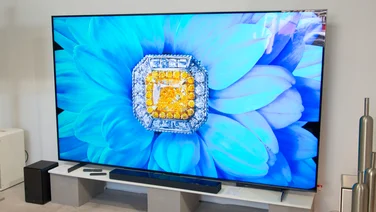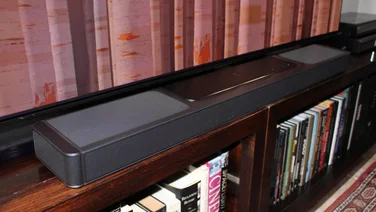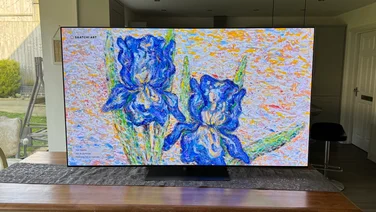To help us provide you with free impartial advice, we may earn a commission if you buy through links on our site. Learn more











Let’s face it: deciphering TV model numbers can seem a thankless task. Letters. Numbers. The occasional cryptic suffix. One model’s name might suggest it’s the latest generation, when it’s only a cosmetic refresh with a slightly different pedestal stand, produced to enable a retailer to claim product exclusivity.
But there’s good news for those drawn to Sony’s 2025 televisions: the brand has recently cleaned house. Enter the new Bravia family – a valiant attempt to bring a little order to the chaos. Helpful if you’re in the market for a new Sony telly – but things are sometimes not always what they seem.
With that in mind, consider this your invaluable guide to decoding Sony’s full TV lineup, from flagship models to budget-friendly impulse buys. Stick with us, and you’ll soon read a model name like K75XR90PU and know precisely what it means. Ready? Let’s dive in.
What you need to know about Sony’s TV lineup
In 2024, Sony’s marketing minds had an epiphany: let’s make things easier. Out went the scattershot naming strategy, and in came the new Bravia naming convention, with clearly tiered lines: Bravia 9, 8, 7, 5, and 3. It’s a hierarchy as neat and orderly as a Japanese Zen garden, at least on the surface.
The majestic Mini LED-powered Bravia 9 sits proudly at the top, followed by the OLED-based Bravia 8, then the Mini LED Bravia 7, the more affordable Bravia 5, and finally, the entry-level Bravia 3. Simple, right? Almost. Sony also left some legacy models in the lineup, which means there’s still some gobbledygook to contend with.
How to decipher Sony TV model numbers
Each component of a Sony TV model number relates to a specific aspect of the television in question. The format differs slightly across the brand’s various ranges, but things are a lot simpler to work out than they were a few years ago.
Let’s take the 65in Bravia 9, which has a model number of K-65XR90, as our example.
K: This can be ignored, as it’s been standard on all Sony TVs since 2024.
65: The number after K relates to the TV’s screen size. So this is a 65in model.
XR: These letters denote the TV’s range. In this case, the Bravia 9 is part of the brand’s current Bravia XR range.
You may also see Sony TVs with “A”, “X” or “W” in their model number. “A” refers to older Sony OLEDs, “X” corresponds to previous LED models, be they Mini LED or Full Array, while “W” covers the company’s HD lineup. Despite the rise of 4K, there’s still a market for HD televisions, so expect Sony to continue making them as long as people are buying them.
9: The final number denotes where the model sits within its range. So here we have the 9 series, which sits at the top of the Bravia range. A higher number typically means a more expensive and impressively specified television.
You may sometimes find other letters at the end of Sony TV model numbers. This generally reflects retailer exclusives or minor differences in the design, such as a different finish or stand. Unless you’re particularly concerned about the aesthetics, ignore these. We all do.
Sony TV model numbers explained: The current Bravia lineup
Sony Bravia 9 (2024)











- Processor: XR Processor
- Panel type: LCD with QD-Mini LED backlight
- Resolution: 3,840 x 2,160
- Refresh rate: 120Hz
- Operating system: Google TV
- Screen sizes: 65in, 75in and 85in
The Bravia 9 is officially Sony’s flagship TV. This Mini LED model is stacked with advanced picture processing tech and extensive functionality, useful if you’re a film fan or a serious gamer.
It boasts Sony’s latest picture processor, offers glorious brightness, has superb HDR handling and has gaming support that hits all the checkboxes (4K/120Hz, VRR, ALLM and so on).
- K-65XR90 | Check price at John Lewis (£2,799)
- K-75XR90 | Check price at Currys (£2,999)
- K-85XR90 | Check price at John Lewis (£3,799)
Sony Bravia 8 (2024)











- Processor: XR Processor
- Panel type: QD-OLED
- Resolution: 3,840 x 2,160
- Refresh rate: 120Hz
- Operating system: Google TV
- Screen sizes: 55in, 65in and 77in
A rung down sits Bravia 8, the spiritual successor to Sony’s popular A80 series. With OLED visuals and a cleaner, more minimalist design, it’s a TV built for cinema purists.
- K-55XR80 | Check price at John Lewis (£1,399)
- K-65XR80 | Check price at Currys (£1,999)
- K-77XR80 | Check price at John Lewis (£2,699)
Sony Bravia 8 II (2025)











- Processor: XR Processor
- Panel type: QD-OLED
- Resolution: 3,840 x 2,160
- Refresh rate: 120Hz
- Operating system: Google TV
- Screen sizes: 55in and 65in
The new Bravia 8 II shakes things up with a brighter QD-OLED panel and is a major upgrade over the standard Bravia 8. It could be argued that the Bravia 8 II should be Sony’s true flagship, dubbed Bravia 10, but Sony’s staying loyal to Mini LED as its crown jewel for now.
The Bravia 8 II is the official replacement for the A95L. However, given that Sony is unable to produce the Bravia 8 II with a 77in QD-OLED panel, the existing A95L continues to fill the gap, thereby keeping the previous naming convention alive.
- K-55XR8M2 | Check price at Sony (£2,499)
- K-65XR8M2 | Check price at Sony (£2,999)
Sony Bravia 7 (2024)











- Processor: XR Processor
- Panel type: LCD with QD-Mini LED backlight
- Resolution: 3,840 x 2,160
- Refresh rate: 120Hz
- Operating system: Google TV
- Screen sizes: 55in, 65in, 75in and 85in
The Bravia 7 is effectively the Bravia 9 for those with a smaller budget. It still uses Mini LED technology, meaning it delivers deep blacks and punchy HDR, but without some of the bells and whistles found in the Bravia 9. It’s still premium and powerful but a little easier on the wallet.
- K-55XR70 | Check price at John Lewis (£1,149)
- K-65XR70 | Check price at John Lewis (£1,699)
- K-75XR70 | Check price at John Lewis (£2,099)
- K-85XR70 | Check price at John Lewis (£2,699)
Sony Bravia 5 (2025)











- Processor: XR Processor
- Panel type: LCD with QD-Mini LED backlight
- Resolution: 3,840 x 2,160
- Refresh rate: 120Hz
- Operating system: Google TV
- Screen sizes: 55in, 65in, 75in, 85in and 98in
A slight step down again is Bravia 5, a Mini LED model designed to give you great picture quality without the extra frills. It’s a solid choice for families and casual viewers who want a vibrant display for everyday viewing and gaming.
What happened to the Bravia 6, you may well ask? That number has been assigned to Sony’s Bravia-branded audio lineup.
- K-55XR5 | Check price at Sony (£1,499)
- K-65XR5 | Check price at Sony (£1,799)
- K-75XR5 | Check price at Sony (£2,199)
- K-85XR5 | Check price at Sony (£2,799)
- K-98XR5 | Check price at Sony (£6,999)
Sony Bravia 3 (2025)











- Processor: 4K HDR Processor X1
- Panel type: LCD
- Resolution: 3,840 x 2,160
- Refresh rate: 120Hz
- Operating system: Google TV
- Screen sizes: 43in, 50in, 55in, 65in, 75in and 85in
At the foot of the Bravia ladder is the Bravia 3. These are standard LED TVs, still branded Bravia, but focused on affordability and simplicity. This is the way to go if you just want a dependable Sony TV that won’t break the bank and want smaller screen size options.
Because the Bravia 3 is powered by a less advanced chip – the 4K HDR Processor X1 – it uses “S” rather than “XR” in its model number.
- K-43S3 | Check price at Sony (£699)
- K-50S3 | Check price at Sony (£799)
- K-55S3 | Check price at Sony (£999)
- K-65S3 | Check price at Sony (£1,299)
- K-75S3 | Check price at Sony (£1,599)
- K-85S3 | Check price at Sony (£1,999)
Sony TV model numbers explained: Other models
Despite the new naming structure, Sony’s previous generation TVs haven’t all disappeared. As mentioned above, the Sony A95L will continue to be sold in its 77in screen size, and you can still find some other attractive options kicking around. We’ve highlighted some of the key models to keep an eye out for below.
Sony A95L (2023)











The A95L was the top television in Sony’s 2023 lineup, and the 77in model will still be produced throughout 2025. Some retailers still have stock of the smaller screen sizes, which should see some generous price cuts as remaining stock is cleared.
Like the Bravia 8, it uses a QD-OLED panel, and you can read more about its performance in our full Sony A95L review.
- XR-55A95L | Check price at Currys (£2,249)
- XR-65A95L | Check price at Currys (£2,879)
- XR-77A95L | Check price at Currys (£4,999)
Sony A90K (2022)











You may have noticed a distinct lack of premium small-screen options in the Bravia lineup above, which is why Sony will continue to sell the 42in and 48in models of the A90K in 2025.
This TV may be getting on a bit, but its OLED panel is powered by a Cognitive Processor XR and still holds up reasonably well, offering a lot of the same picture and audio enhancements used on more recent models.
- XR-42A90K | Check price at John Lewis (£1,199)
- XR-48A90K | Check price at John Lewis (£1,349)
Sony X85L (2023)











The X85WL is a reasonably priced LED model, available in three popular screen sizes. Like the Bravia 3, it uses an iteration of the 4K HDR Processor X1 and uses an LCD panel illuminated by a Full Array LED backlight.
- KD-55X85L | Check price at Currys (£899)
- KD-65X85L | Check price at Currys (£1,099)
- KD-75X85L | Check price at Currys (£1,399)
Sony W800 (2021)











Below these is the W800, an HD 720p resolution small screen for people who covet such things. Its 32in, 60Hz LCD panel has a direct-lit LED backlight with frame dimming, and it uses Android TV rather than Google TV.
- KD-32W800 | Check price at John Lewis (£299)
That pretty much covers Sony’s entire range, unless you’re buying in the US, in which case you’ll also find Sony’s sole 8K behemoth, the Z9, also known as the XR-75Z9K, lurking in the corner.
Sony’s new Bravia structure makes navigating its TV range a whole lot easier, but you’ll still need your wits about you when dipping into legacy models and deciphering model codes.
The good news is that now, when you see a model number like K-55XR8M2, you’ll instantly know it’s a Bravia 8 II OLED, with a 55in screen, and likely to deliver a sensational picture. Now go browse like a boss.





